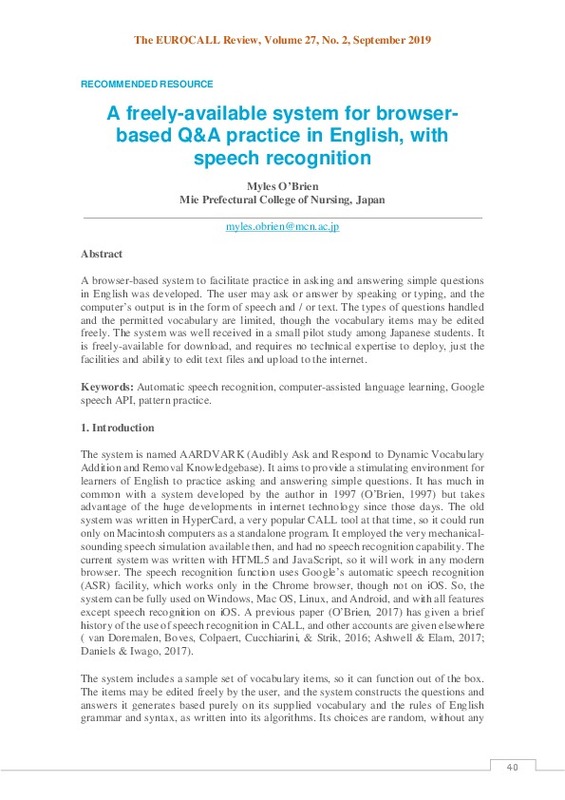Ashwell, T. & Elam, J.R. (2017). How accurately can the Google Web Speech API recognize and transcribe Japanese L2 English learners' oral production?JALT CALL Journal, 13(1), 59-76. https://doi.org/10.29140/jaltcall.v13n1.212
Berkner, V. (2016). Revisiting Input and Output Hypotheses in Second Language Learning. Asian Education Studies, 1(1), 19-22. https://doi.org/10.20849/aes.v1i1.18
Bibauw, S., François, T., & Desmet, P. (2015). Dialogue-based CALL: an overview of existing research. In F. Helm, L. Bradley, M. Guarda, & S. Thouësny (Eds), Critical CALL - Proceedings of the 2015 EUROCALL Conference, Padova, Italy (pp. 57-64). Dublin: Research-publishing.net. https://doi.org/10.14705/rpnet.2015.000310
[+]
Ashwell, T. & Elam, J.R. (2017). How accurately can the Google Web Speech API recognize and transcribe Japanese L2 English learners' oral production?JALT CALL Journal, 13(1), 59-76. https://doi.org/10.29140/jaltcall.v13n1.212
Berkner, V. (2016). Revisiting Input and Output Hypotheses in Second Language Learning. Asian Education Studies, 1(1), 19-22. https://doi.org/10.20849/aes.v1i1.18
Bibauw, S., François, T., & Desmet, P. (2015). Dialogue-based CALL: an overview of existing research. In F. Helm, L. Bradley, M. Guarda, & S. Thouësny (Eds), Critical CALL - Proceedings of the 2015 EUROCALL Conference, Padova, Italy (pp. 57-64). Dublin: Research-publishing.net. https://doi.org/10.14705/rpnet.2015.000310
Bodnar, S., Cucchiarini, C., Penning de Vries, B., Strik, H. & van Hout, R. (2017). Learner affect in computerised L2 oral grammar practice with corrective feedback, Computer Assisted Language Learning, 30(3-4), 223-246. https://doi.org/10.1080/09588221.2017.1302964
Daniels, P., & Iwago, K. (2017). The suitability of cloud-based speech recognition engines for language learning. JALT CALL Journal, 13(3), 211-221. https://doi.org/10.29140/jaltcall.v13n3.220
DeKeyser, R. (2010). Practice for Second Language Learning: Don't Throw out the Baby with the Bathwater. International Journal of English Studies, 10 (1), 2010, 155-165. https://doi.org/10.6018/ijes/2010/1/114021
Donesch-Jezo, E. (2011). The role of output and feedback in second language acquisition - a classroom-based study of grammar acquisition by adult English language learners. Journal of Estonian and Finno-Ugric Linguistics, 2(2), 9-28. https://doi.org/10.12697/jeful.2011.2.2.01
Gimeno-Sanz, A. (2016). Moving a step further from "integrative CALL". What's to come? Computer Assisted Language Learning, 29:6, 1102-1115. https://doi.org/10.1080/09588221.2015.1103271
Iwanaka, T. & Takatsuka, S. (2007). Roles of Output and Noticing in SLA: Does Exposure to Relevant Input Immediately After Output Promote Vocabulary Learning? Annual Review of English Language Education in Japan, 18, 121-130. Retrieved from https://www.jstage.jst.go.jp/article/arele/18/0/18_KJ00007108492/_pdf/-char/en
Jarvis, H. & Krashen, S (2014). Is CALL Obsolete? Language Acquisition and Language Learning Revisited in a Digital Age. TESL-EJ, 17(4), 1-6. Retrieved from http://tesl-ej.org/pdf/ej68/a1.pdf
Jones, C. (Ed.) (2018). Practice in Second Language Learning. Cambridge: Cambridge University press. https://doi.org/10.1017/9781316443118
Këpuska, V., Bohouta,G. (2017). Comparing Speech Recognition Systems (Microsoft API, Google API and CMU Sphinx). Int. Journal of Engineering Research and Application, 7(3), 20-24. https://doi.org/10.9790/9622-0703022024
Krashen, S.D. (1982). Principles and Practice in Second Language Acquisition. London: Pergamon. Retrieved from http://www.sdkrashen.com/content/books/principles_and_practice.pdf
Krashen, S.D. & Terrell, T.D. (1983). The Natural Approach: Language Acquisition in the Classroom. San Francisco: Alemany Press. Retrieved from http://sdkrashen.com/content/books/the_natural_approach.pdf
Krashen, S. (1998). Comprehensible Output. System, 26, 175-182. https://doi.org/10.1016/S0346-251X(98)00002-5
Lyster, R., & Sato, M. (2013). Skill Acquisition Theory and the role of practice in L2 development. In M.G. Mayo, J. Gutierrez-Mangado, & M.M. Adrian (Eds.), Contemporary Approaches to Second Language Acquisition (pp. 71-92). Amsterdam: John Benjamins. https://doi.org/10.1075/aals.9.07ch4
Mennim, P. (2007). Long-term effects of noticing on oral output. Language Teaching Research, 11(3), 265-280. https://doi.org/10.1177/1362168807077551
Ponniah, R. J. and Krashen, S. (2008). The Expanded Output Hypothesis.
The International Journal of Foreign Language Teaching, 4(2), 2-3. Retrieved from https://www.academia.edu/738658/The_expanded_output_hypothesis
Ponniah, R. J. (2010). Insights into Second Language Acquisition Theory and Different Approaches to Language Teaching. Journal on Educational Psychology, 3(4), 14-18. https://doi.org/10.26634/jpsy.3.4.1130
O'Brien, M. (1997). A computer program to provide practice in questions and answers for learners of English. Computer Assisted Language Learning, 10(3), 299-305. https://doi.org/10.1080/0958822970100307
O'Brien, M. (2017). A freely-available authoring system for browser-based CALL with speech recognition. EUROCALL Review, 25(1), 16-25. https://doi.org/10.4995/eurocall.2017.6830
Swain, M. (1985). Communicative competence: some roles of comprehensible input and comprehensible output in its development. In S.M. Gass and C.G. Madden (Eds.) Input in second language acquisition (pp. 235-253). Rowley, MA: Newbury House.
Swain, M. & Lapkin, S. (1995). Problems in Output and the Cognitive Processes they Generate: A Step Towards Second Language Learning. Applied Linguistics, 16(3), 371-91. https://doi.org/10.1093/applin/16.3.371
Sydorenko, T., Smits, T., Evanini, K, & Ramanarayanan, K. (2018). Simulated speaking environments for language learning: insights from three cases. Computer Assisted Language Learning, 32(1-2), 17-48. https://doi.org/10.1080/09588221.2018.1466811
van Doremalen, J., Boves, L., Colpaert, J., Cucchiarini, C, & Strik, H. (2016). Evaluating automatic speech recognition-based language learning systems: A case study. Computer Assisted Language Learning, 29(4), 833-851. https://doi.org/10.1080/09588221.2016.1167090
Warschauer, M. (1996). Computer Assisted Language Learning: An Introduction. In S. Fotos (Ed.), Multimedia language teaching (pp. 3-20). Tokyo: Logos International. Retrieved from http://www.ict4lt.org/en/warschauer.htm
Xu, Y. & Seneff, S. (2009). Speech-Based Interactive Games for Language Learning: Reading, Translation, and Question-Answering. Computational Linguistics and Chinese Language Processing, 14(2), 133-160. Retrieved from https://www.semanticscholar.org/paper/Speech-Based-Interactive-Games-for-Language-and-Xu-Seneff/29c0398871d6b34e9a220e134f90f5cec6dfb86a
[-]








